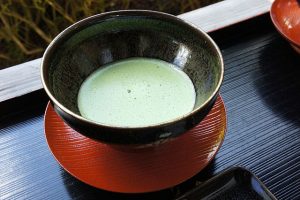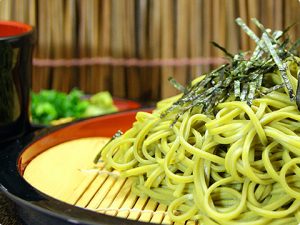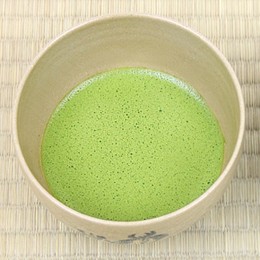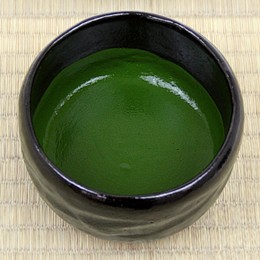Matcha (fine powder tea, 抹茶) is also spelled maccha.
also spelled maccha.
The correct way to spell it according to the Japanese reading would be maccha, but for some reason the term matcha seems to be the standard in English.
I will be using the word matcha as well so as not to cause confusion.
Matcha is a high quality green tea that is finely milled into a powder. Besides being enjoyed as any other green tea, it is the tea used for the Japanese tea ceremony.
Another common use of matcha is as an ingredient in food for green tea color and flavor.
How is matcha made?
The raw material for matcha is tencha. Matcha is made by grinding tencha until a size of 5 to 10 microns (there are 1,000 microns in one millimeter).
This process takes a considerable amount of time, each grinding machine (look at the video below) takes one hour to grind 40 grams!
This video shows how tencha is made and finally how it is milled into matcha.
History of matcha
If you haven´t already, please read my post on the history of green tea.
During the Song Dynasty (from AD 960 to AD 1279), green tea was ground into a powder before being brewed. Since green tea was considered a remedy for many illnesses, it was powdered for consumption as was the custom in Chinese medicine.
Eisai (栄西), a Japanese Buddhist monk that had been studying in China, popularized the drinking of powdered green tea in Japan. He had experienced how Buddhist monks in China drank it to aid in their meditation. Eisai even wrote a book about green tea, the Kissayojoki (喫茶養生記 ) in AD 1214.
In the 16th century Sen no Rikyū (千利休) perfected the Japanese tea ceremony (sado 茶道, also known as chanoyu 茶の湯). Since only matcha is used in the tea ceremony, it became an item of great cultural significance for Japan.
Benefits of matcha
Matcha is naturally high in L-theanine because of tencha’s shading process. Since it’s powdered, you’ll drink the solid parts too and that makes the nutritional value much higher than steeped tea.
For example, you’ll get much more EGCG and vitamins. However, caffeine content is higher as well.
Types of matcha
There are two different ways to brew matcha: usucha (thin tea, 薄茶) and koicha (thick tea, 濃茶). You´ll see in the package if the matcha can be used for usucha, koicha, or even both.
If it doesn’t say anything (as with most brands outside Japan) then its probably for usucha because matcha for koicha is more expensive.
There is culinary grade matcha for using with food (least expensive and lowest quality), normal matcha for everyday use, and ceremonial grade matcha (most expensive and highest quality). Ceremonial grade matcha is used in the Japanese tea ceremony.
Some matcha will even say which school of the Japanese tea ceremony is it intended for! I really don’t know what the difference could be, all I know is that there are many different schools of the Japanese tea ceremony and each one does the ceremony a bit different.
Matcha is also added to other Japanese green teas. When this happens it reads as maccha iri (抹茶入り), such as maccha iri genmaicha (genmaicha with matcha, 抹茶入り玄米茶) and maccha iri sencha (sencha with matcha, 抹茶入り煎茶). This term is also used when food is made with matcha, such as maccha iri soba (soba noodles with matcha, 抹茶入りそば).
green teas. When this happens it reads as maccha iri (抹茶入り), such as maccha iri genmaicha (genmaicha with matcha, 抹茶入り玄米茶) and maccha iri sencha (sencha with matcha, 抹茶入り煎茶). This term is also used when food is made with matcha, such as maccha iri soba (soba noodles with matcha, 抹茶入りそば).
How to brew matcha
I will explain a standard way to brew usucha,  but keep in mind that it’s not the method for the Japanese tea ceremony.
but keep in mind that it’s not the method for the Japanese tea ceremony.
You’ll need the following utensils (see them in the video below):
- Matchawan (抹茶碗). A matcha bowl. Try to get one because it makes the process easier and it looks much better.
- Chasen (茶筅, or 茶筌). A bamboo tea whisk. This one is mandatory.
- Chashaku (茶杓). A bamboo spoon for matcha. Use a normal teaspoon if you don’t have one.
First, pour hot water at a temperature close to the boiling point, into the matchawan to warm it up. Then empty the matchawan and dry it thoroughly. Next, use the chashaku and add 2 scoops (1 teaspoon, about 2 grams) of matcha to the matchawan.
Now you need to add about 60 ml (2 oz) of water at a temperature of 70ºC ~ 80ºC (158ºF ~ 176ºF). You can use the water in step one if it has cooled to the desired temperature.
This is where the fun begins. Grab the matchawan in one hand and with the other hold the chasen in order to whisk the matcha. Start slowly whisking in a W motion and gradually increase the speed. If you tried using a normal cup instead, this motion is harder to do. That’s why I recommend the use of a matchawan.
The result should be a frothy liquid with tiny bubbles in the surface. Don’t leave any big bubbles because it ruins the look of your matcha.
Finally, enjoy your matcha!
For koicha, use more matcha (5 chashaku scoops = 3.75 to 4 grams) less water (about 20 ml = 1 oz)  and the same temperature as for usucha.
and the same temperature as for usucha.
Once you add the matcha, pour the water in two steps, 40% and 60%. Use the whisk slowly (you shouldn’t froth koicha) in an up-down, left-right motion and a 360 rotation.
Your koicha will be thick, but when you drink it, the taste shouldn’t be so bitter that it becomes undrinkable.
If that happens to you, then you’re probably using a matcha that isn’t suited for koicha. Read the label to be sure, and be aware that matcha for koicha is generally more expensive.
Again, I must stress the fact that I’m an absolute beginner when it comes to the Japanese tea ceremony. I just make usucha and koicha in a casual way to drink at home.





August 11, 2018
Hello
If macha is made from tencha and procedure is standard then how different quality of macha comes into picture.Also do we not get same nutrients from all macha powder
August 12, 2018
Hi Espi
The difference between a very expensive matcha and a cheap one has various reasons:
harvest, hand picked or not, shaded in the traditional way or not, ground in the traditional way or not, famous region or not.
Yes, all nutrients are present in each matcha, but the relative quantities change.